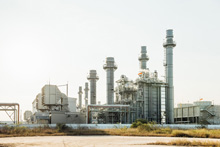The fight against noise pollution is one of ITS's major areas of expertise when it comes to environmental protection.

fighting environmental noise pollution: soundproof gas fired power plant |
Depending on the context, the fight against noise pollution requires the use of various know-how:
- acoustic measurements, when it is necessary to quantify the noise emitted by an organ, a machine or the performance of soundproofing equipment with regard to the limitation of the transmission of sound (building element, silencer, canopy) unless it is a question of evaluating using standardized indicators, for example for an Establishment Classified for Environmental Protection (ECEP) on the one hand the ambient noise (establishment in operation) and on the other hand the residual noise (in the absence of the noise generated by the establishment, but measured over the period of operation of the establishment) for the determination of the emergence
- simulation in acoustics, when it comes to predicting the characteristics of products or constructive systems (soundproofing materials, elements of walls and roofs, doors, silencers ...) or of sets such as enclosures ( shrouds for noise reduction), premises and buildings (in terms of airborne sound insulation or in terms of reverberation) or the impact on the environment of a noise source, given its characteristics (sound power level, directivity) and its installation conditions (sound waves reflection conditions for near-field, soil property, influence of distance and weather conditions on the sound wave path to a receiving point)
- construction technologies (metallic panels on frame often used for industrial soundproofing, but also all types of masonry for many buildings, equipment worked from sheet metal especially for the manufacture of industrial silencers) including the knowledge of the properties of products and constructive systems (for what relates to soundproofing: acoustic insulation or reverberation control of premises) in the context of the erection of a new building or of rehabilitation, without limitation to acoustics but also taking into account related functionalities (sometimes numerous and significant) e.g. resistance to weather and seismic constraints, reaction to fire, thermal insulation and considering also all aspects of regulatory or normative (international or domestic) which are superimposed on the rules of Art applicable to all works.
- knowledge of industrial processes whose maintenance of efficiency is primordial, prevailing over all other considerations in the development and implementation of action plans for limiting noise emissions from noise sources that are associated, which often makes the design of acoustic protection in general and the design of the muffler in particular particularly complex (the aerodynamic performance of such soundproofing devices must often be the subject of a sustained attention e.g. when impacting the efficiency of turbomachines: the conditions of fluid flow basing the operation of combustion turbines, compressors, blowers, fans shall not be affected by a loss of total pressure at intake or exhaust)
- mastery of the general service conditions of various sources of industrial noise (which are the production machinery and equipment of all types) and the ins and outs of their presence in a facility for which a project to combat noise pollution is envisaged
Where possible (because the installation, against which the fight against environmental noise pollution is envisaged, exists), on-site intervention, to collect data to characterize the situation (not only in terms of acoustics but also regarding many related issues) is an important step in the approach proposed by ITS (which can also take over assessments made by others, or base its work on drawings and technical data sheets).
The analysis of the existing situation and the development of solutions to prevent any environmental noise pollution, based on the use of specific computer tools (software developed in-house and tools of recognized publishers) is the heart of the activity of ITS, the result of which can be expected being a clear and precise view not only of the initial state (before soundproofing) but also of the final state as foreseen (after the deployment of noise control means carefully selected for all their functionality), since the performance of equipment marketed by ITS (documented) is guaranteed.
The development of solutions allowing the fight against noise pollution in the environment is the heart of the activity of ITS.
Spread the word !
| See the frequently asked questions related to this article |